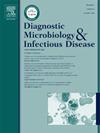56- 21kda抗原嵌合ELISA检测恙虫病东方体感染的建立
IF 2.1
4区 医学
Q3 INFECTIOUS DISEASES
Diagnostic microbiology and infectious disease
Pub Date : 2025-04-11
DOI:10.1016/j.diagmicrobio.2025.116841
引用次数: 0
摘要
目前,用于传统恙虫病诊断的间接荧光抗体检测(IFA)需要较高的生物安全性设施来制备可与类似疾病交叉反应的全细菌抗原。IFA也不适合大规模流行病学调查。因此,需要一种简单、快速、安全、灵敏度和特异性高的血清学诊断方法。在这项研究中,表达了一个嵌合蛋白,结合Karp和Kawasaki血清型的56-kDa蛋白和Gilliam血清型的21-kDa蛋白。利用该嵌合蛋白建立了血清恙虫东方体抗体检测的酶联免疫吸附试验(ELISA)。ELISA与斑疹热、鼠斑疹伤寒、Q热无交叉反应。与IFA相比,ELISA的敏感性和特异性分别为94.9%和97.2%,初步应用时可检出Karp、Gilliam、Kato和Boryong等中国流行的血清型。结果表明,ELISA可用于ST的血清学诊断和大规模血清学调查。可在流行地区进行大规模调查,以作进一步评价。本文章由计算机程序翻译,如有差异,请以英文原文为准。
Development of a chimeric 56-21 kDa antigen-based ELISA for serodiagnosis of Orientia tsutsugamushi infection
At present, indirect fluorescent antibody testing (IFA) for the traditional diagnosis of scrub typhus (ST) requires high biosafety facilities to prepare whole bacterial antigens that can cross-react with similar diseases. IFA is also not suitable for large-scale epidemiological investigation. Therefore, a simple, fast, and safe serological diagnostic method with high sensitivity and specificity is needed. In this study, a chimeric protein was expressed that binds to 56-kDa proteins from Karp and Kawasaki serotypes and 21-kDa from Gilliam. The chimeric protein was used to establish an Enzyme-Linked Immunosorbent Assay (ELISA) to detect antibodies against Orientia tsutsugamushi in serum. ELISA had no cross-reaction with spot fever, murine typhus, and Q fever. Compared with IFA, the sensitivity and specificity of ELISA were 94.9 % and 97.2 %, respectively, and it detected the serotypes prevalent in China, including Karp, Gilliam, Kato, and Boryong in the initial application. The results showed that ELISA could be used for serological diagnosis of ST and large-scale serological investigation. Large-scale surveys in endemic areas can be conducted for further evaluation.
求助全文
通过发布文献求助,成功后即可免费获取论文全文。
去求助
来源期刊
CiteScore
5.30
自引率
3.40%
发文量
149
审稿时长
56 days
期刊介绍:
Diagnostic Microbiology and Infectious Disease keeps you informed of the latest developments in clinical microbiology and the diagnosis and treatment of infectious diseases. Packed with rigorously peer-reviewed articles and studies in bacteriology, immunology, immunoserology, infectious diseases, mycology, parasitology, and virology, the journal examines new procedures, unusual cases, controversial issues, and important new literature. Diagnostic Microbiology and Infectious Disease distinguished independent editorial board, consisting of experts from many medical specialties, ensures you extensive and authoritative coverage.

 求助内容:
求助内容: 应助结果提醒方式:
应助结果提醒方式:


